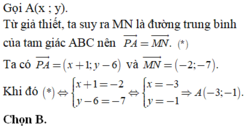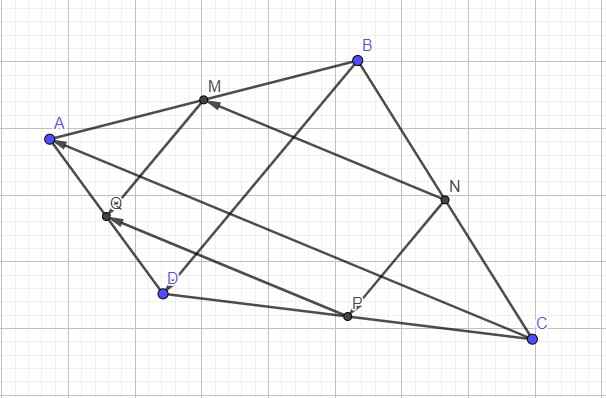Hãy nhập câu hỏi của bạn vào đây, nếu là tài khoản VIP, bạn sẽ được ưu tiên trả lời.

Mình không biết trả lời.Mình mới học lớp 5 thôi .Mong bạn thông cảm nhé!

A B C D M N Q P
a)
MN là đường trung bình của tam giác ABC nên \(\overrightarrow{MN}=\dfrac{1}{2}\overrightarrow{AC}\).
QP là đường trung bình của tam giác ABC nên \(\overrightarrow{QP}=\dfrac{1}{2}\overrightarrow{AC}\).
Vậy \(\overrightarrow{MN}=\overrightarrow{QP}\).
b) Giả sử:
\(\overrightarrow{MP}=\overrightarrow{MN}+\overrightarrow{MQ}\Leftrightarrow\overrightarrow{MP}-\overrightarrow{MN}-\overrightarrow{MQ}=\overrightarrow{0}\)
\(\Leftrightarrow\overrightarrow{MP}+\overrightarrow{NM}+\overrightarrow{QM}=\overrightarrow{0}\)
\(\Leftrightarrow\left(\overrightarrow{QM}+\overrightarrow{MP}\right)+\overrightarrow{NM}=\overrightarrow{0}\)
\(\Leftrightarrow\overrightarrow{QP}+\overrightarrow{NM}=\overrightarrow{0}\)
\(\Leftrightarrow\overrightarrow{QP}-\overrightarrow{MN}=\overrightarrow{0}\)
\(\Leftrightarrow\overrightarrow{QP}-\overrightarrow{QP}=\overrightarrow{0}\)
\(\Leftrightarrow\overrightarrow{0}=\overrightarrow{0}\) ( Điều giả sử đúng).
Vậy \(\overrightarrow{MP}=\overrightarrow{MN}+\overrightarrow{MQ}.\)

Do M là trung điểm AB, Q là trung điểm AD
\(\Rightarrow\) MQ là đường trung bình tam giác ABD
\(\Rightarrow\overrightarrow{MQ}=\dfrac{1}{2}\overrightarrow{BD}\)
Tương tự ta có NP là đường trung bình tam giác BCD
\(\Rightarrow\overrightarrow{NP}=\dfrac{1}{2}\overrightarrow{BD}\)
\(\Rightarrow\overrightarrow{NP}=\overrightarrow{MQ}\)
b. MN là đường trung bình tam giác ABC
\(\Rightarrow\overrightarrow{NM}=\dfrac{1}{2}\overrightarrow{CA}\)
PQ là đường trung bình tam giác ACD
\(\Rightarrow\overrightarrow{PQ}=\dfrac{1}{2}\overrightarrow{CA}\)
\(\Rightarrow\overrightarrow{PQ}=\overrightarrow{NM}\)

Đặt \(\overrightarrow{PB}=x\overrightarrow{BC}\)
\(\overrightarrow{PM}=\overrightarrow{PB}+\overrightarrow{BM}=x.\overrightarrow{BC}-\dfrac{1}{3}\overrightarrow{AB}\)
\(\overrightarrow{PN}=\overrightarrow{PC}+\overrightarrow{CN}=\left(x+1\right)\overrightarrow{BC}-\dfrac{1}{2}\overrightarrow{AC}=\left(x+1\right)\overrightarrow{BC}-\dfrac{1}{2}\left(\overrightarrow{AB}+\overrightarrow{BC}\right)\)
\(=\left(x+\dfrac{1}{2}\right)\overrightarrow{BC}-\dfrac{1}{2}\overrightarrow{AB}\)
P, M, N thẳng hàng \(\Rightarrow\dfrac{x+\dfrac{1}{2}}{x}=\dfrac{\dfrac{1}{2}}{\dfrac{1}{3}}\Rightarrow x=1\) \(\Rightarrow\overrightarrow{PB}=\overrightarrow{BC}\)
\(\Rightarrow\) B là trung điểm PC \(\Rightarrow P\left(-6;5\right)\)
Nếu bạn chưa học bài pt đường thẳng thì làm cách trên, còn học rồi thì đơn giản là thiết lập 2 pt đường thẳng BC và MN là xong

O A B x y a b -b H
a) Do AB//Ox và tam giác OAB đều nên điểm A đối xứng với điểm B qua Ox.
Suy ra: AB = 2 = 2b. Nên b = 1.
Áp dụng định lý Pi-ta-go: \(OH=\sqrt{AB^2-HA^2}=\sqrt{2^2-1^2}=\sqrt{3}\).
Suy ra: \(a=\sqrt{3}\Rightarrow x_A=\sqrt{3};y_B=-\sqrt{3}\).
Vậy \(A\left(1;\sqrt{3}\right),B\left(-1;-\sqrt{3}\right)\).



Bài 3:
vecto AN+vecto BP+vecto CM
=\(\dfrac{1}{2}\left(\overrightarrow{AB}+\overrightarrow{AC}+\overrightarrow{BA}+\overrightarrow{BC}+\overrightarrow{CA}+\overrightarrow{CB}\right)\)
\(=\dfrac{1}{2}\cdot\overrightarrow{0}=\overrightarrow{0}\)